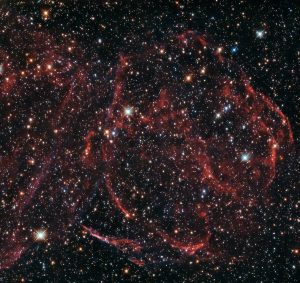La fine di una stella

Questa immagine del telescopio Hubble immortala i resti di una stella morta da tempo. I filamenti ondulati di gas ionizzato, dal nome DEM L316A, si trovano a circa 160.000 anni luce di distanza, all’interno di una delle galassie più vicine alla Via Lattea, la Grande Nube di Magellano (Large Magellanic Cloud).
L’esplosione che ha formato DEM L316A è stata un esempio di un tipo di supernova particolarmente energetica e luminosa, conosciuta come supernova di tipo Ia. Si ritiene che simili eventi si verifichino quando una stella nana bianca strappa più materiale di quanto sia in grado di gestire da una compagna vicina.
Il risultato è uno spettacolare rilascio di energia sotto forma di brillante, violenta esplosione, che ha espulso gli strati esterni della stella nello spazio circostante a velocità elevatissime. Quando questo gas viaggia attraverso il materiale interstellare lo riscalda e lo ionizza, producendo il debole bagliore che la camera a bordo di Hubble ha ripreso in questa splendida immagine.
[ Barbara Bubbi ]
http://www.spacetelescope.org/images/potw1630a/?utm_medium=social&utm_campaign=SocialSignIn&utm_source=Facebook
Credit: ESA/Hubble & NASA, Y. Chu
Lascia un commento